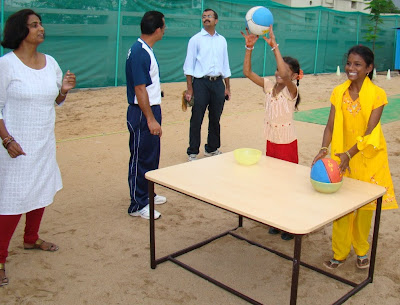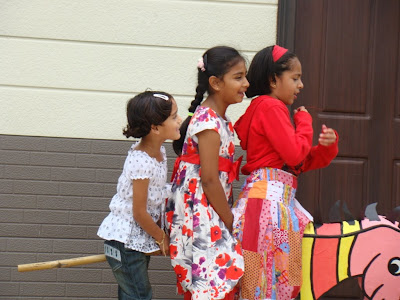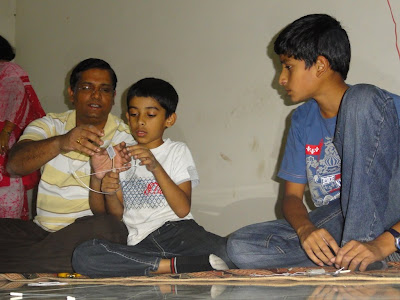Monday, November 29, 2010
Wednesday, November 24, 2010
Progress on the building








We think that is a wonderful idea and so, from this week onwards, look out for some great updates.
And Thank You , Mr. Purey !
Monday, November 22, 2010
WHEN SHOULD KIDS START SPORTS?
It's not easy to determine how early to start children in organized sports. Children of the same age vary considerably in their physical and psychological maturation, and there is no practical method of measuring maturity. Assuming the child has shown interest, five or six is the generally accepted earliest starting age for organized team sports. At the early ages participation should be limited to sports that involve a lot of physical activity and encourage the development of major motor muscles.
Children in grades 1 - 4 can benefit most from games that are modified to meet their needs and abilities. Play and fun are more important to this age group than highly structured sports that emphasize the outcome rather than the process. Parents and coaches are usually the ones concerned about winning and losing. When helping your child select a sport, keep balance in mind. Encourage your children to try many sports and activities when young and not to think of specializing or playing competitively until they reach middle school. Make sure a balance also occurs between adult organized activities and free playtime. Children need time to just be kids and to play with other kids without a set of rules or adult involvement.
The most important decisions to make, are which youth sports organizations and which coaches are best for your child. Make sure that you take the time to find out about the league, its leaders and coaches. Better yet, get involved and volunteer to coach. Participating in sports is a healthy way, both physically and socially, for your children to channel their youthful energy in a positive direction. Make sure your children's first experience encourages them to begin a lifelong interest in physical activities and good health.
Resource Page:
http://www.ksnusa.org/articles/startsports.htm
Posted by: Paramjit and Olga Suri
Sunday, November 21, 2010
READING IS LEARNT BY READING

Billions of people across the world learn to read using a diverse array of practices – from
the “phonetic” to the “whole sentence” approach. Many children’s first exposure to the
English language is through “nonsensical” rhymes like “Ba-Ba Black Sheep” or “Ring a
ring a roses” – poems which make little sense to their contexts and whose roots are often
macabre. Are there other ways more conducive to get children to read?
Many children experience difficulty with formal reading instruction based on exercises,
material and drills that are to a large extent nonsensical. The philosophy of this kind of
instruction, called “programmatic”, is that reading is a set of skills which can be taught
and mastered in a pre-determined sequence, provided there are frequent tests.
Programmatic instruction is the antithesis of meaningful language experience for teachers
and children. It is primarily a method of control.
Frank Smith in his famous book “Reading” throws light on the process of reading itself.
He proposes the idea of “the literacy club” which children need to join if they are to
become successful readers. At the heart of Frank Smith’s analysis is the seemingly simple
truth that it is only through reading that children learn to read. He describes the ease with
which children become literate when they are personally involved with people actually
making use of the signs, labels, lists, newspapers, magazines and books in the world
around them.
Making Sense
John Holt the famous American educationist recalls a very interesting case. The school
was meant for Black African children and was situated in a low-income area. The
children were not interested in the standard state text books. And if the books and their
contents did not interest the children there was no way the teacher could coerce them into
reading. Many teachers tried the usual ways and failed, until a young lady teacher
changed it all. She was a fresher, just finished her teacher training course and was
looking for new innovative ideas to foster reading. It did not take her long to realize that
her students were not interested in the dry state sponsored text books. Her class was
largely composed of poor Black African students. Most of them had never read or
possessed a book; but their lives were full of music. What she did was simple. She wrote
the popular numbers and songs the children sang in big letters on chart sheets and hung
them on the classroom wall. As the children already knew the songs by-heart they were
soon reading them. For once the written word made “sense” to them – the scribbling on
the charts described their lives, their pains, their aspirations. This interested the children
immensely. This was their “take-off” point in reading.
Context and Relevance
This brings us to the whole question of context and relevance. Often the curriculum is so
far removed from the lives of the learner that he/she fails to make any sense of it. The
plethora of “adult-education” material in India is ample testimony to it. It is often totally
divorced from the life of the learner and the “exploitative” context of his / her life. No
wonder adult education classes never elicited any popular response and died their own
death. The whole vocabulary itself is “loaded” against the un-schooled poor. For instance
the first alphabet in Hindi “Ka” for “Karz” (indebtedness) would be more appropriate for
the dispossessed than “Ka” for “Kabootar” (pigeon). Similar “Sa” for “Sood” (interest on
borrowing) would be more appropriate for the oppressed than “Sa” for “Saraswati”.
Sylvia Ashton Warner in her famous book “Spinster” writes, “What a dangerous activity
reading is; teaching is. All this plastering on of foreign stuff! Why plaster on at all when
there’s so much inside already? So much locked in? If only I could get it out and use it as
working material. And not draw on it either. If I had a light enough touch it would just
come out under its own volcanic power.”
Sylvia was teaching Maori children in New Zealand to read. She stuck “labels” on all
familiar objects in the classroom. Small cards with “fan” “table” “bench” “blackboard”
“door” written on them were stuck at appropriate places. Children would see them often,
read them and soon become friends with them. Sylvia encouraged children to recount
their stories, tell their experiences which she wrote down in the children’s own words.
And because they were the children’s own stories they loved reading them and drew
pictures to illustrate them. In one semester this poor village school in New Zealand
produced over 60 illustrated stories, each a record of their experiences, in short a tapestry
of their own lives.
Following a similar method Paulo Freire began by talking with Brazilian peasants about
the conditions and problems of their lives, and showed them how to read and write those
words which were most important for them. He found that it took only about 30 hours
before the wretchedly poor and demoralised peasants were able to explore reading on
their own. In the process they also traced the roots of their exploitation.
Not the word but the world!
Gijubhai Badheka was a contemporary of Gandhiji. For 24 years he ran the most creative
school for children in Bhavnagar, Gujarat. Everyday he told children a story – which
captivated them and whetted their appetite for more. In the afternoons the children would
enact out those stories. Soon they became so adept with words that there was no need to
mug-up the dialogues by “rote”. If they forgot a few lines, they could “invent” them on
the spot. Gijubhai felt it was totally illogical and foolish for every child to have the same
state sponsored textbook. He said, “What could be more foolish than all the 50 children
having the same book.” So, when the new session began Gijubhai urged the children not
to buy “textbooks” but instead give him the money for buying story books. So, in the
1920’s Gijubhai swept aside textbooks and bought 3 different story books for every child.
With this large collection of illustrated storybooks he started a classroom library. This
was a library with the children’s own money – not gifted by Unicef, Pratham or the
World Bank. Instead of three textbooks children could now read over a hundred
colorfully illustrated storybooks. Gijubhai’s progressive vision of education “not the
word but the world” has been replicated by few schools since independence.
By Arvind Gupta
Thursday, November 18, 2010
A Glimpse into our Cultural Heritage
On the occasion of Bakr Id children at Sancta Maria watched a presentation on the celebration of Bakr Id. One of our teachers Ms. Kawaljeet Babra showed a presentation in which she briefed on the history of celebrating Bakr Id. The children greeted each other by hugging and saying Id Mubarak. Bakr Id or Id-ul-Zuha is one of the most celebrated festivals among Muslims all over the world.
Monday, November 15, 2010
Children's Day Celebration @Sancta Maria













 Children wave goodbye as they leave the school; clutching their gifts and treats !
Children wave goodbye as they leave the school; clutching their gifts and treats !
M2 (Margaret & Meena)
Thursday, November 11, 2010
A TEACHER'S SURVIVAL KIT FOR EVERYDAY LIVING

I found this while browsing the net...Happy Reading!!
TOOTHPICK-
.....reminds us to look for the good qualities in our students. You may be the only teacher who says something positive to them that day.
RUBBER BAND-
......reminds the teacher that they have to be flexible. Things don't always go the way we plan, But flexibility will help to work it out.
BAND AID-
......reminds the teacher that sometimes we do more than teach, That we help heal hurt feelings, broken dreams, And lend an ear to a problem.
PENCIL-
......reminds us to be thankful and we should list our blessings daily, But also encourage our students to list their blessings And to be proud of their accomplishments.
ERASER-
......reminds us to allow students to know we are human And make mistakes just like they do, and it's OK. We must all be able to learn from our mistakes.
CHEWING GUM-
.......reminds us to stick with it And encourage our students to do like wise. Even the impossible task or assignment can be accomplished by sticking to it.
MINT-
.....reminds us and our students we are worth a mint. (We may not be paid a mint, but are worth it!)
CANDY KISS-
........reminds us that everyone needs a hug, Kiss, or warm a smile everyday. (All teachers, students, parents, and even administrators)
TEA BAG-
......reminds us we need time to relax, Go over our blessing, and take time for others. Family, husbands, wives, friends, children need quality time together.
A teacher must be willing to show their students how much they care!!!
Resource Page:
http://homepages.tesco.net/~derek.berger/teachers.html
Monday, November 8, 2010
Letting Go Of The 'Cruise Control' Button!

I was once going through a bumpy spell when it seemed like nothing I tried was working with one particular class. I found myself being crabby with a colleague who always seemed to possess a positive outlook, no matter what the situation. I told her that I felt very uncomfortable about the advancement of that one class, and that many of the students seemed to lack the essential basic skills to study the subject matter.
My colleague continued to share her simple attitude that has further transformed not only my teaching vocation, but my personal life as well. She suggested that having an exigent class like the one I had was a blessing more than a burden.
She asked me, “Has this class made you more... or less creative?” “More”, I said. She asked, “Has this class caused you to be more or less resourceful?” Again, I replied, “More.” She continued, “Has this class led you to pray more... or less?” I laughed and said, “MUCH, much more!!.” She then she made her point.
She told me that the last thing a teacher should ever want is to become “comfortable.” She continued saying that comfort breeds complacency, which leads to a false sense of security. She said that whenever we get comfortable, we tend to develop a false sense of confidence and security. We believe we’re in full control of a situation. Often, that false sense of security allows us to take things for granted, including our class.
Often, when a subject, lesson, or class becomes easy, it’s also easy to shift into a pattern of 'cruise control'. This kind of attitude of complacency can sometimes lead us to not push ourselves to a higher level of excellence.
The truth is, when everything’s comfortable, we actually believe we’re in control of things. But when things get uncomfortable, God gently reminds us of who’s really in control: He is. Comfort is…comfortable, but remember, it’s not the goal. The goal is constant and never-ending improvement. Such a simple shift in our thinking can make a huge difference in our performance both in and outside the classroom.
So step outside your “comfort zone” and thank God for the “tough ones.”
Friday, November 5, 2010
Show and Tell - On the Spot!
The kids usually come prepared with objects for their Show and Tell days. But the other day when the first graders forgot to bring an object from home, they searched for objects from the classroom and spoke spontaneously: hardly any preparation done. The result was a natural, spontaneous, and a presentation done with no 'adult interference'. Here is a glimpse of them...
ROCKY TALK! SEEDY TALK!
Thursday, November 4, 2010
Educationally Enriched ...


The delegates for this programme comprise of educational leaders from 15 countries across the world, which include Bahrain, Bhutan, Eritrea, Jordan, Mexico, Nigeria, Oman, Phillipines, Sensgal, Singapore, Sudan, Rwanda, Russia, and, Uruguay.

Most importantly, the group will get to observe day to day activities at various elementary schools, high schools, teacher training colleges, district and state educational boards across the USA.
We Sancta Marians count ourselves lucky for our Principal to have gotten such a rare opportunity, and we are eagerly waiting for her return, so that all of us, students, staff and parents, may profit from her learnings.

























